[English] 日本語
 Yorodumi
Yorodumi- EMDB-12564: Substrate receptor scaffolding module of human CTLH E3 ubiquitin ... -
+ Open data
Open data
- Basic information
Basic information
| Entry | Database: EMDB / ID: EMD-12564 | |||||||||
|---|---|---|---|---|---|---|---|---|---|---|
| Title | Substrate receptor scaffolding module of human CTLH E3 ubiquitin ligase | |||||||||
 Map data Map data | ||||||||||
 Sample Sample |
| |||||||||
 Keywords Keywords | GID / CTLH / ubiquitin / E3 ligase / supramolecular assembly / metabolism / gluconeogenesis / cryoEM / LIGASE | |||||||||
| Function / homology |  Function and homology information Function and homology informationGID complex / L1CAM interactions / positive regulation of amyloid precursor protein catabolic process / microtubule nucleation / microtubule associated complex / ubiquitin ligase complex / MET activates RAS signaling / cytoskeleton organization / Regulation of pyruvate metabolism / negative regulation of ERK1 and ERK2 cascade ...GID complex / L1CAM interactions / positive regulation of amyloid precursor protein catabolic process / microtubule nucleation / microtubule associated complex / ubiquitin ligase complex / MET activates RAS signaling / cytoskeleton organization / Regulation of pyruvate metabolism / negative regulation of ERK1 and ERK2 cascade / small GTPase binding / specific granule lumen / Wnt signaling pathway / ubiquitin protein ligase activity / cell junction / tertiary granule lumen / positive regulation of canonical Wnt signaling pathway / RAF/MAP kinase cascade / protein-containing complex assembly / proteasome-mediated ubiquitin-dependent protein catabolic process / nuclear body / intracellular membrane-bounded organelle / positive regulation of cell population proliferation / Neutrophil degranulation / enzyme binding / protein homodimerization activity / extracellular region / nucleoplasm / nucleus / plasma membrane / cytosol / cytoplasm Similarity search - Function | |||||||||
| Biological species |  Homo sapiens (human) Homo sapiens (human) | |||||||||
| Method | single particle reconstruction / cryo EM / Resolution: 3.3 Å | |||||||||
 Authors Authors | Chrustowicz J / Sherpa D / Prabu JR / Schulman BA | |||||||||
| Funding support |  Germany, 2 items Germany, 2 items
| |||||||||
 Citation Citation |  Journal: Mol Cell / Year: 2021 Journal: Mol Cell / Year: 2021Title: GID E3 ligase supramolecular chelate assembly configures multipronged ubiquitin targeting of an oligomeric metabolic enzyme. Authors: Dawafuti Sherpa / Jakub Chrustowicz / Shuai Qiao / Christine R Langlois / Laura A Hehl / Karthik Varma Gottemukkala / Fynn M Hansen / Ozge Karayel / Susanne von Gronau / J Rajan Prabu / ...Authors: Dawafuti Sherpa / Jakub Chrustowicz / Shuai Qiao / Christine R Langlois / Laura A Hehl / Karthik Varma Gottemukkala / Fynn M Hansen / Ozge Karayel / Susanne von Gronau / J Rajan Prabu / Matthias Mann / Arno F Alpi / Brenda A Schulman /  Abstract: How are E3 ubiquitin ligases configured to match substrate quaternary structures? Here, by studying the yeast GID complex (mutation of which causes deficiency in glucose-induced degradation of ...How are E3 ubiquitin ligases configured to match substrate quaternary structures? Here, by studying the yeast GID complex (mutation of which causes deficiency in glucose-induced degradation of gluconeogenic enzymes), we discover supramolecular chelate assembly as an E3 ligase strategy for targeting an oligomeric substrate. Cryoelectron microscopy (cryo-EM) structures show that, to bind the tetrameric substrate fructose-1,6-bisphosphatase (Fbp1), two minimally functional GID E3s assemble into the 20-protein Chelator-GID, which resembles an organometallic supramolecular chelate. The Chelator-GID assembly avidly binds multiple Fbp1 degrons so that multiple Fbp1 protomers are simultaneously ubiquitylated at lysines near the allosteric and substrate binding sites. Importantly, key structural and biochemical features, including capacity for supramolecular assembly, are preserved in the human ortholog, the CTLH E3. Based on our integrative structural, biochemical, and cell biological data, we propose that higher-order E3 ligase assembly generally enables multipronged targeting, capable of simultaneously incapacitating multiple protomers and functionalities of oligomeric substrates. #1:  Journal: Biorxiv / Year: 2021 Journal: Biorxiv / Year: 2021Title: GID E3 ligase supramolecular chelate assembly configures multipronged ubiquitin targeting of an oligomeric metabolic enzyme Authors: Sherpa D / Chrustowicz J / Qiao S / Langlois CR / Hehl LA / Gottemukkala KV / Hansen FM / Karayel O / Prabu JR / Mann M / Alpi AF / Schulman BA | |||||||||
| History |
|
- Structure visualization
Structure visualization
| Movie |
 Movie viewer Movie viewer |
|---|---|
| Structure viewer | EM map:  SurfView SurfView Molmil Molmil Jmol/JSmol Jmol/JSmol |
| Supplemental images |
- Downloads & links
Downloads & links
-EMDB archive
| Map data |  emd_12564.map.gz emd_12564.map.gz | 9.2 MB |  EMDB map data format EMDB map data format | |
|---|---|---|---|---|
| Header (meta data) |  emd-12564-v30.xml emd-12564-v30.xml emd-12564.xml emd-12564.xml | 28.9 KB 28.9 KB | Display Display |  EMDB header EMDB header |
| FSC (resolution estimation) |  emd_12564_fsc.xml emd_12564_fsc.xml | 12.5 KB | Display |  FSC data file FSC data file |
| Images |  emd_12564.png emd_12564.png | 132.6 KB | ||
| Masks |  emd_12564_msk_1.map emd_12564_msk_1.map | 166.4 MB |  Mask map Mask map | |
| Filedesc metadata |  emd-12564.cif.gz emd-12564.cif.gz | 8.1 KB | ||
| Others |  emd_12564_additional_1.map.gz emd_12564_additional_1.map.gz emd_12564_half_map_1.map.gz emd_12564_half_map_1.map.gz emd_12564_half_map_2.map.gz emd_12564_half_map_2.map.gz | 146.6 MB 131.3 MB 131.9 MB | ||
| Archive directory |  http://ftp.pdbj.org/pub/emdb/structures/EMD-12564 http://ftp.pdbj.org/pub/emdb/structures/EMD-12564 ftp://ftp.pdbj.org/pub/emdb/structures/EMD-12564 ftp://ftp.pdbj.org/pub/emdb/structures/EMD-12564 | HTTPS FTP |
-Validation report
| Summary document |  emd_12564_validation.pdf.gz emd_12564_validation.pdf.gz | 772.1 KB | Display |  EMDB validaton report EMDB validaton report |
|---|---|---|---|---|
| Full document |  emd_12564_full_validation.pdf.gz emd_12564_full_validation.pdf.gz | 771.6 KB | Display | |
| Data in XML |  emd_12564_validation.xml.gz emd_12564_validation.xml.gz | 19.5 KB | Display | |
| Data in CIF |  emd_12564_validation.cif.gz emd_12564_validation.cif.gz | 25.4 KB | Display | |
| Arichive directory |  https://ftp.pdbj.org/pub/emdb/validation_reports/EMD-12564 https://ftp.pdbj.org/pub/emdb/validation_reports/EMD-12564 ftp://ftp.pdbj.org/pub/emdb/validation_reports/EMD-12564 ftp://ftp.pdbj.org/pub/emdb/validation_reports/EMD-12564 | HTTPS FTP |
-Related structure data
| Related structure data |  7nscMC  7ns3C  7ns4C 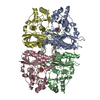 7ns5C  7nsbC C: citing same article ( M: atomic model generated by this map |
|---|---|
| Similar structure data |
- Links
Links
| EMDB pages |  EMDB (EBI/PDBe) / EMDB (EBI/PDBe) /  EMDataResource EMDataResource |
|---|---|
| Related items in Molecule of the Month |
- Map
Map
| File |  Download / File: emd_12564.map.gz / Format: CCP4 / Size: 166.4 MB / Type: IMAGE STORED AS FLOATING POINT NUMBER (4 BYTES) Download / File: emd_12564.map.gz / Format: CCP4 / Size: 166.4 MB / Type: IMAGE STORED AS FLOATING POINT NUMBER (4 BYTES) | ||||||||||||||||||||||||||||||||||||||||||||||||||||||||||||
|---|---|---|---|---|---|---|---|---|---|---|---|---|---|---|---|---|---|---|---|---|---|---|---|---|---|---|---|---|---|---|---|---|---|---|---|---|---|---|---|---|---|---|---|---|---|---|---|---|---|---|---|---|---|---|---|---|---|---|---|---|---|
| Projections & slices | Image control
Images are generated by Spider. | ||||||||||||||||||||||||||||||||||||||||||||||||||||||||||||
| Voxel size | X=Y=Z: 0.85 Å | ||||||||||||||||||||||||||||||||||||||||||||||||||||||||||||
| Density |
| ||||||||||||||||||||||||||||||||||||||||||||||||||||||||||||
| Symmetry | Space group: 1 | ||||||||||||||||||||||||||||||||||||||||||||||||||||||||||||
| Details | EMDB XML:
CCP4 map header:
| ||||||||||||||||||||||||||||||||||||||||||||||||||||||||||||
-Supplemental data
-Mask #1
| File |  emd_12564_msk_1.map emd_12564_msk_1.map | ||||||||||||
|---|---|---|---|---|---|---|---|---|---|---|---|---|---|
| Projections & Slices |
| ||||||||||||
| Density Histograms |
-Additional map: #1
| File | emd_12564_additional_1.map | ||||||||||||
|---|---|---|---|---|---|---|---|---|---|---|---|---|---|
| Projections & Slices |
| ||||||||||||
| Density Histograms |
-Half map: #2
| File | emd_12564_half_map_1.map | ||||||||||||
|---|---|---|---|---|---|---|---|---|---|---|---|---|---|
| Projections & Slices |
| ||||||||||||
| Density Histograms |
-Half map: #1
| File | emd_12564_half_map_2.map | ||||||||||||
|---|---|---|---|---|---|---|---|---|---|---|---|---|---|
| Projections & Slices |
| ||||||||||||
| Density Histograms |
- Sample components
Sample components
-Entire : SRS module of human CTLH complex comprising RANBP9, TWA1, ARMC8 a...
| Entire | Name: SRS module of human CTLH complex comprising RANBP9, TWA1, ARMC8 and hGid4 |
|---|---|
| Components |
|
-Supramolecule #1: SRS module of human CTLH complex comprising RANBP9, TWA1, ARMC8 a...
| Supramolecule | Name: SRS module of human CTLH complex comprising RANBP9, TWA1, ARMC8 and hGid4 type: complex / ID: 1 / Parent: 0 / Macromolecule list: all / Details: Generated by focused refinement of CTLH SR4 map |
|---|---|
| Source (natural) | Organism:  Homo sapiens (human) Homo sapiens (human) |
| Molecular weight | Theoretical: 210 KDa |
-Macromolecule #1: Ran-binding protein 9
| Macromolecule | Name: Ran-binding protein 9 / type: protein_or_peptide / ID: 1 / Number of copies: 1 / Enantiomer: LEVO |
|---|---|
| Source (natural) | Organism:  Homo sapiens (human) Homo sapiens (human) |
| Molecular weight | Theoretical: 77.927062 KDa |
| Recombinant expression | Organism:  Trichoplusia ni (cabbage looper) Trichoplusia ni (cabbage looper) |
| Sequence | String: MSGQPPPPPP QQQQQQQQLS PPPPAALAPV SGVVLPAPPA VSAGSSPAGS PGGGAGGEGL GAAAAALLLH PPPPPPPATA APPPPPPPP PPPASAAAPA SGPPAPPGLA AGPGPAGGAP TPALVAGSSA AAPFPHGDSA LNEQEKELQR RLKRLYPAVD E QETPLPRS ...String: MSGQPPPPPP QQQQQQQQLS PPPPAALAPV SGVVLPAPPA VSAGSSPAGS PGGGAGGEGL GAAAAALLLH PPPPPPPATA APPPPPPPP PPPASAAAPA SGPPAPPGLA AGPGPAGGAP TPALVAGSSA AAPFPHGDSA LNEQEKELQR RLKRLYPAVD E QETPLPRS WSPKDKFSYI GLSQNNLRVH YKGHGKTPKD AASVRATHPI PAACGIYYFE VKIVSKGRDG YMGIGLSAQG VN MNRLPGW DKHSYGYHGD DGHSFCSSGT GQPYGPTFTT GDVIGCCVNL INNTCFYTKN GHSLGIAFTD LPPNLYPTVG LQT PGEVVD ANFGQHPFVF DIEDYMREWR TKIQAQIDRF PIGDREGEWQ TMIQKMVSSY LVHHGYCATA EAFARSTDQT VLEE LASIK NRQRIQKLVL AGRMGEAIET TQQLYPSLLE RNPNLLFTLK VRQFIEMVNG TDSEVRCLGG RSPKSQDSYP VSPRP FSSP SMSPSHGMNI HNLASGKGST AHFSGFESCS NGVISNKAHQ SYCHSNKHQS SNLNVPELNS INMSRSQQVN NFTSND VDM ETDHYSNGVG ETSSNGFLNG SSKHDHEMED CDTEMEVDSS QLRRQLCGGS QAAIERMIHF GRELQAMSEQ LRRDCGK NT ANKKMLKDAF SLLAYSDPWN SPVGNQLDPI QREPVCSALN SAILETHNLP KQPPLALAMG QATQCLGLMA RSGIGSCA F ATVEDYLH UniProtKB: Ran-binding protein 9 |
-Macromolecule #2: Isoform 2 of Armadillo repeat-containing protein 8
| Macromolecule | Name: Isoform 2 of Armadillo repeat-containing protein 8 / type: protein_or_peptide / ID: 2 / Number of copies: 1 / Enantiomer: LEVO |
|---|---|
| Source (natural) | Organism:  Homo sapiens (human) Homo sapiens (human) |
| Molecular weight | Theoretical: 74.082297 KDa |
| Recombinant expression | Organism:  Trichoplusia ni (cabbage looper) Trichoplusia ni (cabbage looper) |
| Sequence | String: MEVTASSRHY VDRLFDPDPQ KVLQGVIDMK NAVIGNNKQK ANLIVLGAVP RLLYLLQQET SSTELKTECA VVLGSLAMGT ENNVKSLLD CHIIPALLQG LLSPDLKFIE ACLRCLRTIF TSPVTPEELL YTDATVIPHL MALLSRSRYT QEYICQIFSH C CKGPDHQT ...String: MEVTASSRHY VDRLFDPDPQ KVLQGVIDMK NAVIGNNKQK ANLIVLGAVP RLLYLLQQET SSTELKTECA VVLGSLAMGT ENNVKSLLD CHIIPALLQG LLSPDLKFIE ACLRCLRTIF TSPVTPEELL YTDATVIPHL MALLSRSRYT QEYICQIFSH C CKGPDHQT ILFNHGAVQN IAHLLTSLSY KVRMQALKCF SVLAFENPQV SMTLVNVLVD GELLPQIFVK MLQRDKPIEM QL TSAKCLT YMCRAGAIRT DDNCIVLKTL PCLVRMCSKE RLLEERVEGA ETLAYLIEPD VELQRIASIT DHLIAMLADY FKY PSSVSA ITDIKRLDHD LKHAHELRQA AFKLYASLGA NDEDIRKKII ETENMMDRIV TGLSESSVKV RLAAVRCLHS LSRS VQQLR TSFQDHAVWK PLMKVLQNAP DEILVVASSM LCNLLLEFSP SKEPILESGA VELLCGLTQS ENPALRVNGI WALMN MAFQ AEQKIKADIL RSLSTEQLFR LLSDSDLNVL MKTLGLLRNL LSTRPHIDKI MSTHGKQIMQ AVTLILEGEH NIEVKE QTL CILANIADGT TAKDLIMTND DILQKIKYYM GHSHVKLQLA AMFCISNLIW NEEEGSQERQ DKLRDMGIVD ILHKLSQ SP DSNLCDKAKM ALQQYLA UniProtKB: Armadillo repeat-containing protein 8 |
-Macromolecule #3: Glucose-induced degradation protein 8 homolog
| Macromolecule | Name: Glucose-induced degradation protein 8 homolog / type: protein_or_peptide / ID: 3 / Number of copies: 1 / Enantiomer: LEVO |
|---|---|
| Source (natural) | Organism:  Homo sapiens (human) Homo sapiens (human) |
| Molecular weight | Theoretical: 30.796715 KDa |
| Recombinant expression | Organism:  Trichoplusia ni (cabbage looper) Trichoplusia ni (cabbage looper) |
| Sequence | String: MSYAEKPDEI TKDEWMEKLN NLHVQRADMN RLIMNYLVTE GFKEAAEKFR MESGIEPSVD LETLDERIKI REMILKGQIQ EAIALINSL HPELLDTNRY LYFHLQQQHL IELIRQRETE AALEFAQTQL AEQGEESREC LTEMERTLAL LAFDSPEESP F GDLLHTMQ ...String: MSYAEKPDEI TKDEWMEKLN NLHVQRADMN RLIMNYLVTE GFKEAAEKFR MESGIEPSVD LETLDERIKI REMILKGQIQ EAIALINSL HPELLDTNRY LYFHLQQQHL IELIRQRETE AALEFAQTQL AEQGEESREC LTEMERTLAL LAFDSPEESP F GDLLHTMQ RQKVWSEVNQ AVLDYENRES TPKLAKLLKL LLWAQNELDQ KKVKYPKMTD LSKGVIEEPK SDENLYFQSG WS HPQFEKG GGSGGGSGGS AWSHPQFEK UniProtKB: Glucose-induced degradation protein 8 homolog |
-Macromolecule #4: Glucose-induced degradation protein 4 homolog
| Macromolecule | Name: Glucose-induced degradation protein 4 homolog / type: protein_or_peptide / ID: 4 / Number of copies: 1 / Enantiomer: LEVO |
|---|---|
| Source (natural) | Organism:  Homo sapiens (human) Homo sapiens (human) |
| Molecular weight | Theoretical: 33.559906 KDa |
| Recombinant expression | Organism:  |
| Sequence | String: MCARGQVGRG TQLRTGRPCS QVPGSRWRPE RLLRRQRAGG RPSRPHPARA RPGLSLPATL LGSRAAAAVP LPLPPALAPG DPAMPVRTE CPPPAGASAA SAASLIPPPP INTQQPGVAT SLLYSGSKFR GHQKSKGNSY DVEVVLQHVD TGNSYLCGYL K IKGLTEEY ...String: MCARGQVGRG TQLRTGRPCS QVPGSRWRPE RLLRRQRAGG RPSRPHPARA RPGLSLPATL LGSRAAAAVP LPLPPALAPG DPAMPVRTE CPPPAGASAA SAASLIPPPP INTQQPGVAT SLLYSGSKFR GHQKSKGNSY DVEVVLQHVD TGNSYLCGYL K IKGLTEEY PTLTTFFEGE IISKKHPFLT RKWDADEDVD RKHWGKFLAF YQYAKSFNSD DFDYEELKNG DYVFMRWKEQ FL VPDHTIK DISGASFAGF YYICFQKSAA SIEGYYYHRS SEWYQSLNLT HVPEHSAPIY EFR UniProtKB: Glucose-induced degradation protein 4 homolog |
-Experimental details
-Structure determination
| Method | cryo EM |
|---|---|
 Processing Processing | single particle reconstruction |
| Aggregation state | particle |
- Sample preparation
Sample preparation
| Buffer | pH: 7.5 |
|---|---|
| Vitrification | Cryogen name: ETHANE |
- Electron microscopy
Electron microscopy
| Microscope | FEI TITAN KRIOS |
|---|---|
| Image recording | Film or detector model: GATAN K3 BIOQUANTUM (6k x 4k) / Average electron dose: 60.0 e/Å2 |
| Electron beam | Acceleration voltage: 300 kV / Electron source:  FIELD EMISSION GUN FIELD EMISSION GUN |
| Electron optics | Illumination mode: FLOOD BEAM / Imaging mode: BRIGHT FIELD |
| Experimental equipment |  Model: Titan Krios / Image courtesy: FEI Company |
 Movie
Movie Controller
Controller















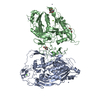

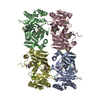
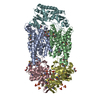


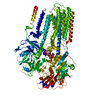







 Z (Sec.)
Z (Sec.) Y (Row.)
Y (Row.) X (Col.)
X (Col.)






















































